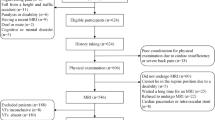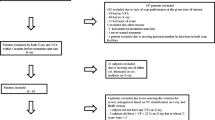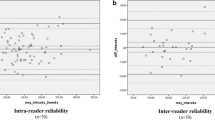Abstract
Introduction
Patients discontinuing or neglecting denosumab treatment are at risk of sustaining rebound-associated vertebral fractures (RAVFs). In everyday clinical practice, conventional X-rays are used to diagnose such events in patients reporting acute back pain.
Patients
Herein we report the cases of two patients, in whom magnetic resonance imaging (MRI) depicted more RAVFs or allowed earlier detection of RAVFs compared with conventional X-rays.
Conclusion
It seems that, in the setting of RAVFs following denosumab discontinuation, MRI imaging provides better accuracy in the diagnostic process and in the classification assessment compared to conventional X-rays, thus allowing an earlier and clearer picture of the magnitude of spinal damage. This could have an impact on clinical decisions and improve patient’s management.


Similar content being viewed by others
Data availability
Images can be available upon request.
References
H.K. Genant, C.Y. Wu, C. van Kuijk, M.C. Nevitt, Vertebral fracture assessment using a semiquantitative technique. J. Bone Miner. Res. 8, 1137–48 (1993)
F. Grados, C. Roux, M.C. de Vernejoul, G. Utard, J.L. Sebert, P. Fardellone, Comparison of four morphometric definitions and a semiquantitative consensus reading for assessing prevalent vertebral fractures. Osteoporos. Int. 12, 716–22 (2001)
G. Marongiu, S. Congia, M. Verona, M. Lombardo, D. Podda, A. Capone, The impact of magnetic resonance imaging in the diagnostic and classification process of osteoporotic vertebral fractures. Injury 49(Suppl 3), S26–S31 (2018)
U.J. Spiegl, R. Beisse, S. Hauck, A. Grillhosl, V. Buhren, Value of MRI imaging prior to a kyphoplasty for osteoporotic insufficiency fractures. Eur. Spine J. 18, 1287–92 (2009)
A.D. Anastasilakis, S.A. Polyzos, P. Makras, Therapy of endocrine disease: denosumab vs. bisphosphonates for the treatment of postmenopausal osteoporosis. Eur. J. Endocrinol. 179, R31–R45 (2018)
H.G. Bone, R.B. Wagman, M.L. Brandi, J.P. Brown, R. Chapurlat, S.R. Cummings, E. Czerwinski, A. Fahrleitner-Pammer, D.L. Kendler, K. Lippuner, J.Y. Reginster, C. Roux, J. Malouf, M.N. Bradley, N.S. Daizadeh, A. Wang, P. Dakin, N. Pannacciulli, D.W. Dempster, S. Papapoulos, 10 years of denosumab treatment in postmenopausal women with osteoporosis: results from the phase 3 randomised FREEDOM trial and open-label extension. Lancet Diabetes Endocrinol. 5, 513–523 (2017)
A.D. Anastasilakis, M.P. Yavropoulou, P. Makras, G.T. Sakellariou, F. Papadopoulou, S. Gerou, S.E. Papapoulos, Increased osteoclastogenesis in patients with vertebral fractures following discontinuation of denosumab treatment. Eur. J. Endocrinol. 176, 677–683 (2017)
A.D. Anastasilakis, S.A. Polyzos, P. Makras, B. Aubry-Rozier, S. Kaouri, O. Lamy, Clinical features of 24 patients with rebound-associated vertebral fractures after denosumab discontinuation: systematic review and additional cases. J. Bone Miner. Res. 32, 1291–1296 (2017)
S.R. Cummings, S. Ferrari, R. Eastell, N. Gilchrist, J.B. Jensen, M. McClung, C. Roux, O. Torring, I. Valter, A.T. Wang, J.P. Brown, Vertebral fractures after discontinuation of denosumab: a post hoc analysis of the randomized placebo-controlled FREEDOM trial and its extension. J. Bone Miner. Res. 33, 190–198 (2018)
A.D. Anastasilakis, S.E. Papapoulos, S.A. Polyzos, N.M. Appelman-Dijkstra, P. Makras, Zoledronate for the prevention of bone loss in women discontinuing denosumab treatment. a prospective 2-year clinical trial. J. Bone Miner. Res. 34, 2220–2228 (2019)
M.R. McClung, R.B. Wagman, P.D. Miller, A. Wang, E.M. Lewiecki, Observations following discontinuation of long-term denosumab therapy. Osteoporos. Int. 28, 1723–1732 (2017)
J. Leroux, P.H. Vivier, M. Ould Slimane, E. Foulongne, S. Abu-Amara, J. Lechevallier, J. Griffet, Early diagnosis of thoracolumbar spine fractures in children. A prospective study. Orthop. Traumatol. Surg. Res. 99, 60–65 (2013)
R. Niimi, T. Kono, A. Nishihara, M. Hasegawa, T. Kono, A. Sudo, Rebound-associated vertebral fractures after discontinuation of denosumab for the treatment of maxillitis. Osteoporos. Int. 29, 769–772 (2018)
A.W. Popp, P.K. Zysset, K. Lippuner, Rebound-associated vertebral fractures after discontinuation of denosumab-from clinic and biomechanics. Osteoporos. Int. 27, 1917–1921 (2016)
K.M. Qasem, A. Suzuki, K. Yamada, M. Hoshino, T. Tsujio, S. Takahashi, H. Nakamura, Discriminating imaging findings of acute osteoporotic vertebral fracture: a prospective multicenter cohort study. J. Orthop. Sur. Res 9, 96 (2014)
Author information
Authors and Affiliations
Contributions
A.D.A.: conceptualization, methodology, validation, writing original draft, and supervision; G.E.: data curation, resources, and visualization; P.M.: writing review and editing visualization; A.I.: conceptualization, resources, writing reviewing, and editing.
Corresponding author
Ethics declarations
Conflict of interest
A.D.A. reports lecture fees from Amgen, Bianex, Eli-Lilly and ITF; G.E. has nothing to declare; P.M. reports honoraria for lectures and research grants from Amgen; lecture fees from Glaxo, Lilly, Pfizer, Leo, Genesis, Elpen, and Vianex. A.I. reports lecture fees from Amgen, MSD, and Novartis.
Informed consent
Informed consent was obtained from the patients for publication of their case reports and accompanying images.
Additional information
Publisher’s note Springer Nature remains neutral with regard to jurisdictional claims in published maps and institutional affiliations.
Rights and permissions
About this article
Cite this article
Anastasilakis, A.D., Evangelatos, G., Makras, P. et al. Magnetic resonance imaging has an advantage over conventional spine X-rays in the evaluation of rebound-associated vertebral fractures following denosumab discontinuation. Endocrine 69, 516–518 (2020). https://doi.org/10.1007/s12020-020-02333-1
Received:
Accepted:
Published:
Issue Date:
DOI: https://doi.org/10.1007/s12020-020-02333-1




